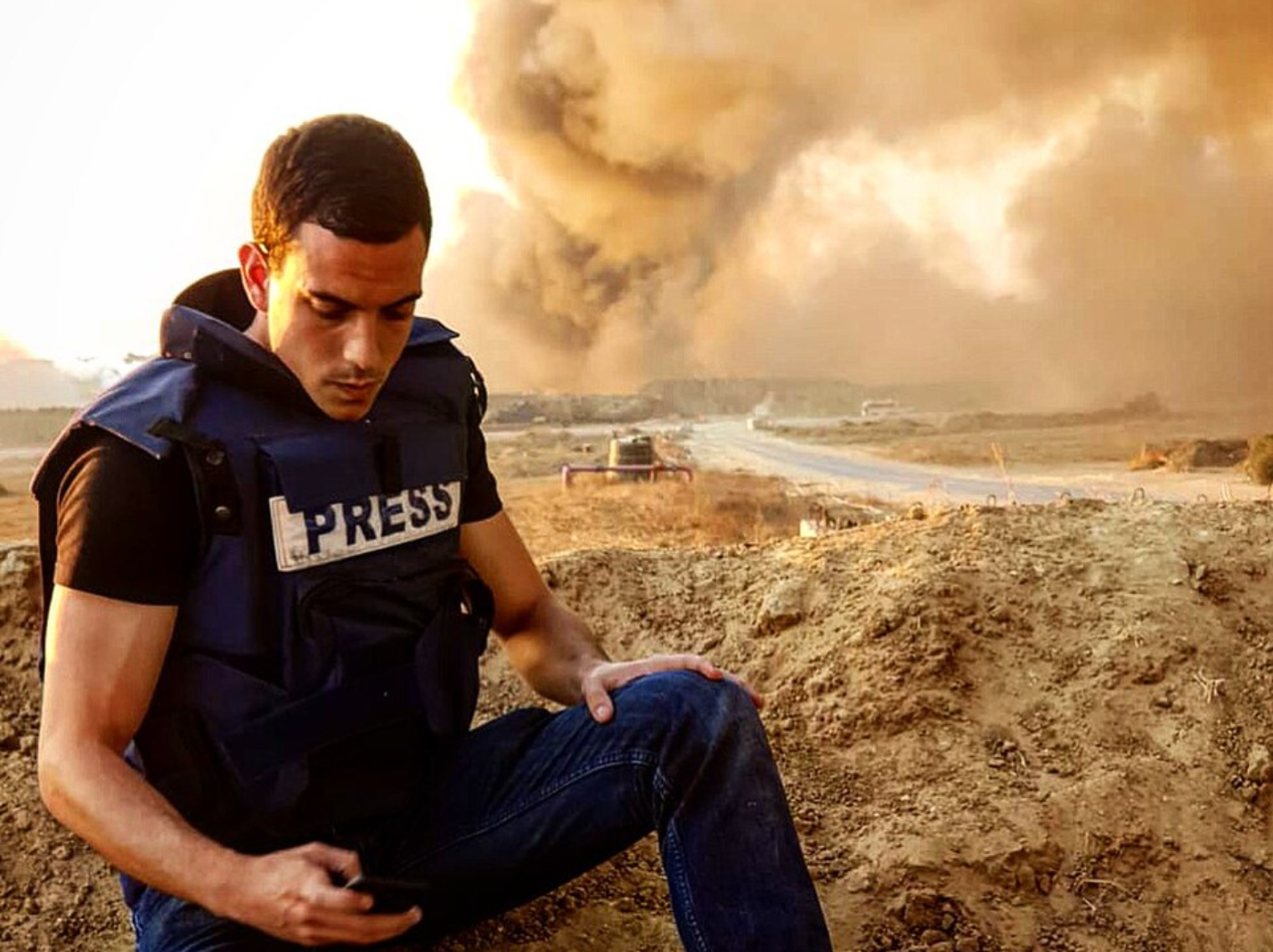
Is there any news that is not fake news?
The question is not rhetorical. Some media sources are admittedly engaged in partisan politics under the guise of news reporting, but many at least give an obligatory nod to the notion of journalism as something in principle separable from propaganda. One wonders, though, if any news media adhere to a real, practical commitment to getting to the truth, especially when that truth cuts against presuppositions the reporters, the audience, or the media source’s funders hold dear.
Fox News foreign correspondent Trey Yingst’s book, Black Saturday: An Unfiltered Account of the October 7th Attack on Israel and the War in Gaza, as the title indicates, concerns the October 2023 Hamas terror attack on Israel, but it is also about this question of objectivity in journalism. We do well to remember that reporting bias exists in multiple forms. A story with several objectively plausible interpretations might be told in a purely unidirectional manner, and this is biased. But it is another form of bias to pursue a forced notion of balance in a story in which there is no equivalency between the claims made by the various sides. Yingst’s narrative exemplifies the latter error.
As part of his energetic effort to assure us he is not taking sides, he portrays Israel and Hamas in equal terms as motivated solely by winning the conflict and therefore equally apt to distort truths. “[T]wo things can be true at once,” Yingst writes. For example: “The killing of innocent Israelis on October 7th was … a horrible slaughter [that] will have consequences … Also, innocent Palestinian lives must be protected.” However, he somehow fails to address the question of how Israel could do what it must—protect itself from the terrorist threat at its doorstep—without loss of innocent Palestinian lives when Hamas was committed to doing everything possible to sacrifice those lives for their cause.
[RELATED: David Eltis Recovers the Complex, Global Truth Behind the Atlantic Slave Trade]
Our journalists would have done well here to mention how Hamas spoke about the strategy behind the October 7 attack. They have been quite straightforward about their desire to make casualties as high as possible for the Palestinian side. The evidence is clear that Hamas uses civilians as human shields. The Hamas leadership is on record saying that “millions of martyrs” will be required for Palestine’s “liberation.” They have acknowledged that they knew the Israeli response to this atrocity would be overwhelming, and they have classed the massive loss of Palestinian civilian life as a necessary “sacrifice.” They could hardly have been more sanguine in condemning millions of their compatriots to the dust in the interest of their ideological cause.
Yingst repeatedly claims that Palestinians have an incredibly complicated set of attitudes regarding Israel and Jews. Some are committed to the genocidal terrorist anti-Semitism of Hamas, but many others are just trying to live their lives, perfectly content to accept coexistence with Israel. The data we have on this question are not strongly supportive of Yingst’s belief. Asked to rate the humanity of Jews on a scale of 1-100 on a recent survey, the average Palestinian scores it at six. Not six on a scale of ten. Six on a scale of 100. And more than seven in every ten Palestinians give Jews a zero on this humanity scale.
These terrifying results are not a consequence of the recent war and its concomitant suffering. Palestinians have broadly thought this way about Israel and the Jews for a long time. An Anti-Defamation League survey from more than a decade ago found that 93 percent of Palestinians held anti-Jewish beliefs. More recently, a poll by the Washington Institute found that half of Gazans and nearly sixty percent of those in the West Bank disagreed that Hamas should stop calling for the elimination of the state of Israel. Nearly seven in ten in both the West Bank and Gaza view Hamas positively. Support for suicide bombing is higher here—approximately 40 percent of Palestinians say it is justified—than nearly anywhere else in the Muslim world.
These facts are hardly startling to those who have followed the rise of Hamas from its origins. Voters awarded it a “huge majority” of parliamentary seats in 2006. The Palestinian people as a whole hold significant responsibility for the fact that a terrorist group that openly calls for the destruction of the Israeli state is in power in Gaza.
Yingst balances the Israeli charge that they did not start the present war against the Palestinian counter that Gaza had already been under occupation for decades before it began, but he does not raise the question of why the latter is the case. Since its founding in the late 1980s, Hamas has carried out terrorist attacks against Israel. It responded to the 1993 Oslo Accords with a campaign of bombings. Within six months of the start of a unilateral Israeli withdrawal from Gaza, this terrorist organization that had built the destruction of Israel into its charter became the governing party in Gaza. Can a people be expected to respond to such a history by unguardedly embracing the entity that has expressly committed itself to their extinction and the population that voted it into power?
Black Saturday contains many more examples of false equivalency between the two sides.
Yingst documents several stunning cases of Palestinian sources blatantly lying about details on the ground, but his conclusion from this is to reiterate how hard journalism is because everybody in a war situation has an interest in their own agenda. The Israelis lie too, he claims. He describes refusing to air the report from the Israel Defense Forces on Hamas tunnels under Shifa hospital, which was issued as justification for a bombing strike there, as untrustworthy. But he does not subsequently indicate what was discovered—and reported on even by such typically pro-Palestinian sources as CNN—when Israeli forces reached the hospital. They discovered a network of underground tunnels, exactly as Israeli intelligence had reported.
Yingst mentions, without critical scrutiny, a Hamas official comparing the Israeli call for Gazans to evacuate the areas of their strategic attacks on Hamas to the mass flight of Arab Palestinians in the wake of the creation of the state of Israel, i.e., the Nakba. He also notes reports that Hamas was, in fact, preventing civilians from leaving the affected areas. He does nothing to explore further this notion of the Nakba, which has become a quasi-mythological justification for Palestinian militancy against Israel.
The Nakba is frequently cited as indisputable grounds for viewing Israel as the aggressor and the Palestinians as the hapless victims in this conflict. The historical details are not fully settled, and indeed, they are stubbornly difficult to disentangle from the ideological biases of many of the historical narrators. But it is not disputed that this mass flight took place only after the Arab powers rejected the November 1947 plan of the United Nations to create separate Arab and Jewish states in Palestine. In short order, Arabs in Mandatory Palestine started terrorist attacks against Jews, including the Jerusalem Riots in which more than a hundred Jews were killed and injured. The Arab High Committee blockaded Jews in Jerusalem and launched attacks on Jewish communities. Arab militias outside Palestine began entering the war that had been declared against Israel by Arabs the very day after the May 1948 UN resolution created the Israeli state. The so-called Nakba occurs in this context. The authoritative body of the world’s nations voted on a peaceful resolution of a problem—imperfect, but an effort to find a viable solution that would be reasonably fair on all sides. The proto-Israelis agreed to it. The Palestinians and neighboring Arab groups responded to that global resolution by immediately launching into a mass slaughter of Jews.
[RELATED: Vedder’s Case for Creative Destruction]
We should not be so shocked that the response to the actions of Arabs in and around Palestine in late 1947 and early 1948 might have ended up including the expulsion of Arabs from the new Jewish state. Critics of Israel, such as the historian Ilan Pappé, have used the inappropriate term “ethnic cleansing” to describe this episode. (Wikipedia notably follows suit). But other historians, such as Benny Morris, have posed a compelling response. If the only alternative to something like the Nakba is genocide of your own people—which, again, significant forces among the Arabs have been calling for since the effort to form a Jewish state there began—then the Nakba becomes entirely justifiable. To leave a fifth column inside Israel, after the Palestinian Arabs and their other Arab allies had already declared war on you, would have been a suicidal decision.
When Yingst leaves unexamined and unchallenged claims like this, in which the Nakba mythology is used to guide how one should think about Gazans being evacuated from a war zone in 2023, he is inevitably positioning his narrative in a partisan manner. This is a way of doing fake news.
The most compelling part of Yingst’s book consists of detailed reminders of the horrors of the attack on October 7th. Young women at a concert were kidnapped and taken into Gaza to be systematically raped and tortured; whole families were blown up with grenades while huddling in their home shelters; gleeful Hamas terrorists, accompanied by Gazan civilians along for the murderous adventure, filmed themselves with GoPros as they mowed victims down like cattle. The people across the political spectrum who want to equivocate on where the blame is to be placed for this long-term conflict should be confronted with these data, leavened by the historical facts described above, on a 24/7 schedule.
We can thank Yingst for his contribution to the collective memory of the October 7 nightmare. In what it gives us in the way of a lesson on objective political journalism, however, Black Saturday must be classified as a disappointment.
Find more book reviews here.
Image: “Trey Yingst In the Field” by TreyYingst on Wikimedia Commons

We are done with you. The only ones believing you are boomers glued to Fox News and thank God they are dropping like flies these days. Trey Yingst and MTG know that the nest generation will not tolerate an America infested with agents of a foreign country 5,000 miles away.